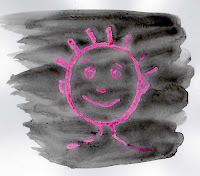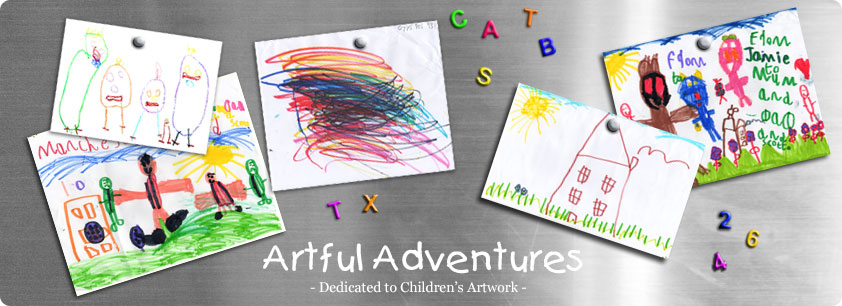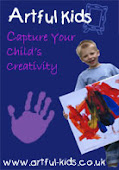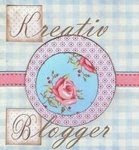Wednesday 31 March 2010
Is your Child's Artwork important to you?
I am trying to do some 'strategic thinking' in terms of the direction my business should take. There are lots of different ways in which it, and I could go, and while I have my own opinions about this, I feel that any decision I make really should be informed by the wider world out there as far as possible.
You see, I take the artwork of my children very seriously. I was, and still am, thrilled to watch my kid's artwork develop, change and progress, and love to encourage them. I hate to discard any of their work, and the best is carefully preserved, used or presented in a way to really show it off.
However, I sometimes suspect I am not typical in this respect, and that the majority of parents take no more than a passing interest, if any, in their child's work, and while they might stick it on the fridge or on the kitchen wall, or their child's bedroom wall, they wouldn't dream of putting it in the living room for example, let alone have it expensively framed as they might a photograph of the child themselves.
I enjoy doing what I do, and carrying out commissions for people. The response I get is really satisfying for me personally. But long-term, as a business, I need to be sure that what I am offering is something that people have an interest in, if it is to develop as I would like.
Admittedly it's very early days, for me to be suffering a crisis of confidence - I have barely started promoting it, but I thought I would at least try to ask the question to inform any decision I make. So.... is your child's artwork important to you? Is it something that you would preserve for posterity or display prominently in your house? What do you normally do with it? I would love to know what everyone thinks, so please give me your feedback!
Thursday 25 March 2010
Artful Kids Competition - win a unique piece of personalised artwork
I have just launched my first competition for Artful Kids, in association with Raring to Go magazine. To take part I am inviting readers of the magazine, and of Artful Adventures, to submit a photo of their children's artwork, which will be turned into a unique, and personalised piece of contemporary canvas wall-art measuring at least 30x30cms and worth a minimum of £85.
This is just one of the options I currently offer at Artful Kids, but it is the most creatively satisfying and challenging for me, as the child's artwork is transformed into something new, while retaining the distinctive feel and integrity of the original. Every piece is unique, as the approach taken is very much dictated by what the original work inspires. You can see a few 'before and after' photos here which give you some idea of the wide variety of styles this can result in. A digital proof is always supplied before production goes ahead, to ensure that the customer is happy with the finished result.
To enter, you need to submit a photograph of your child's artwork, by posting it on your blog and adding your link below. Alternatively you can send your image as a Jpeg to: info@artful-kids.co.uk. The closing date for all entries is 30th April, and the winning piece of artwork will be selected the following week.
Best of luck!
Labels:
Artful Kids,
artwork,
Children,
competition,
drawing,
kids,
painting
Monday 22 March 2010
March Featured Artist

This month's Featured Artist has been contributed by Mollimoo, and is by her daughter, aged 3. The intriguing title of this one is 'Me riding an Elephant Snake!' I think it's quite accomplished for a 3 year old.
The monthly Featured Artist is selected from images uploaded to the Artful Kids Flickr Group.
If anyone has any masterpieces (drawings and paintings) created by children under 12 that they would like to contribute to the group, your contributions would be very welcome.
The monthly Featured Artist is selected from images uploaded to the Artful Kids Flickr Group.
If anyone has any masterpieces (drawings and paintings) created by children under 12 that they would like to contribute to the group, your contributions would be very welcome.
Are you adding a note or a person?
Labels:
Artful Kids,
artwork,
Children,
featured artist,
Flickr,
kids
Wednesday 17 March 2010
Crayon Cookies
Following on from my last post on wax crayons, I thought I would introduce this project for Crayon Cookies which uses up all those odd bits and pieces of broken crayons that you always end up with.
Method
Remove all the paper from the crayons - I found this was easier if they were soaked in water for a few minutes first.
Using an old muffin tray, divide up the crayons between the different sections. The advice is to use an old muffin tin, but I thought I could get round this by using muffin cases - wrong! The wax still got onto the tin, but it did clean up quite easily with soap and really hot water. You can have great fun at this stage, the kids can get involved, and you can divide the colours out however you like. I decided to stick to colour families, so I used shades of green in one, shades of blue in another, pinks and purples in a third, and so on. The kids did a couple of 'harlequin' cookies, with a complete mixture of colours.
Place the tin in a warm oven which has been pre-heated to 150 degrees. As soon as the tin goes in, turn the oven off, and leave the crayons to slowly melt. It's quite difficult to judge this stage - at the end of the period, not all of my crayons had melted, so I turned the oven on again at a low heat and left it a little longer. However this resulted in them becoming a little too liquid! Possibly it depends on the performance of your oven.
When they have melted sufficiently for the individual crayons to have 'merged' but with the individual colours remaining distinct, carefully remove the tin from the oven and allow to cool.
I made my crayon cookies standard muffin size, which meant they were quite chunky for little hands to hold as crayons, and I had to cut them into quarters (this does have the advantage that it gives you a good point to use). If you want to cut them, I found that the easiest way to do it was to heat a good strong cutting knife over the gas flame, and use the hot knife to cut the cookie. Alternatively you could bake them as mini-muffins if you have the appropriate tin, though I think this would restrict you to only using the thinner crayons.
I can't remember where I came across the idea originally - it was in pre-blogging days, and I didn't take a note of it at the time, but in looking for some detailed insturctions I found this post by Ten Ten helpful.
Another tutorial by Chica and Jo, uses ice-cube trays with completely melted crayons in individual colours to create a more sophisticated crayon with layers of colour. They look wonderful, but I decided I didn't have the patience for this. You can find it here.
Friday 12 March 2010
Art Materials - Wax Crayons
It's been a little while since I started this series off with Canvas, and I thought it was about time I continued it. This time I'm going to look at that staple tool of any self-respecting budding artist - wax crayons. Traditional, cheap, practical, easy to use, these are so ubiquitous that their creative potential is perhaps sometimes a little overlooked. Personally I have found that all wax crayons are not alike. They differ amazingly - you can get short fat stubby, chunky crayons, or long, thin ones. Some are hard and plasticky, others (perhaps unsurprisingly) soft and waxy. Some will produce a dense, bright colour, others a pale washed-out colour. Unfortunately, you can't tell just by looking at them how effective they will be, and price doesn't always seem to be a guide either. Some of the best I have found have been given out as freebies at restaurants.
Wax crayons are really effective for colouring large areas quickly and for creating large, simple drawings, but their unique characteristics make them especially suitable for the following kinds of projects:
Texture rubbings
Leaves, bark, brass rubbings, coins, wood grain, stone - lots of fun can be had with a piece of paper and a wax crayon - it's something that everyone must have done at some time or another - simple, but magical to a child, as an image appears before their eyes.
Resist Work
This technique exploits the water-resistant qualities of wax crayons. Again simple yet very effective. You create your drawing in wax crayon, and wash over it with a watery paint. You can get different effects depending upon how thick the paint is, and the colour of the drawing beneath. Used with a very watery paint and a white crayon, the effect is light and delicate, but wash over a bright wax crayon drawing with a denser black paint (not too thick or the paint will simply obliterate the drawing) and the effect is much richer and more dramatic. Alternatively, if the pictures are small you can use a felt tip marker pen over the wax crayon (see Really Rachel's Magic Pictures). To get the best effect, the wax crayon has to be applied fairly densely under pressure, which requires some strength to do. For this reason, very young children are likely to need some help with the drawing.
Sgraffito
This technique has 3 stages and is most suitable for older children who have more strength to apply the necessary pressure.
1. Create a colourful background with wax crayon, felt tips or paint (or cheat and use colourful paper)
2. Cover it densely with black wax crayon, applying as much pressure as possible.
3. Using something like a cocktail stick, draw your picture by scraping away the black wax crayon and revealing the coloured surface below.
The same effect can be created rather less cheaply using Crayola Color Explosion - Rainbow paper and pens. I bought some of this for my kids (OK it was for me really) and they (or me) had great fun with it.
paper and pens. I bought some of this for my kids (OK it was for me really) and they (or me) had great fun with it.
Wax crayons have lots of creative potential, so if anyone else has any projects they've created using them, feel free to add a comment with a link below. In the meantime, here are one or two that I have already come across:
Valentine's Card Water-painting
Leaf Rubbings
Magic Pictures
Wax crayons are really effective for colouring large areas quickly and for creating large, simple drawings, but their unique characteristics make them especially suitable for the following kinds of projects:
Texture rubbings
Leaves, bark, brass rubbings, coins, wood grain, stone - lots of fun can be had with a piece of paper and a wax crayon - it's something that everyone must have done at some time or another - simple, but magical to a child, as an image appears before their eyes.
Resist Work
 |
| A dark wash over bright crayon creates strong contrast |
 |
| A pale wash over white crayon creates a delicate effect |
Sgraffito
 |
| First create a brightly coloured background |
1. Create a colourful background with wax crayon, felt tips or paint (or cheat and use colourful paper)
2. Cover it densely with black wax crayon, applying as much pressure as possible.
3. Using something like a cocktail stick, draw your picture by scraping away the black wax crayon and revealing the coloured surface below.
 |
| Add a dense black layer of crayon over the top, and scratch a design or picture into it. |
 | ||
| This example was created with a felt-tip background |
The same effect can be created rather less cheaply using Crayola Color Explosion - Rainbow
 |
| Firework scene created with Crayola's Colour Explosion paper and pens |
Valentine's Card Water-painting
Leaf Rubbings
Magic Pictures
Labels:
art,
Children,
resist work,
sgraffito,
texture rubbings,
wax crayons
Monday 8 March 2010
My First Awards
I recently received my first 2 blog awards, in one week - the Kreativ Blogger Award from Plan B, and the Sunshine Award from JoolzKay. I have often thought that my blog here is not ideally suited for awards, because lots of them require you to be able to blog about anything and everything, whereas this one has a specific theme. Anyway, for the Kreativ Blogger award you are required to list 7 things which you haven't told your readers before, so I thought I would use Plan B's excellent idea of giving my list a creative theme to fit in better with this blog, so here goes:
- I also have another website at Scribble Art where I sell personalised artwork for kids (OK, some of you may already have realised this, but I've never actually written about it - yet!)
- I'm about to launch my first collection of Artful Kids items for sale at NotontheHighStreet.
- I have a new product for Artful Kids which I am about to launch shortly - watch this space!
- I'm currently working on a new idea for some hand-painted T-shirts. This is something of a learning curve for me, as it entails getting to grips with a whole plethora of new techniques, tools and materials which I'm unfamiliar with.
- I'm increasingly getting into digital art - another steep learning curve - but I love the way you can play around to your heart's content, without messing the whole thing up - you can always undo any mistakes.
- I am greatly inspired by naive and folk art - I love the emphasis upon the 2 dimensional surface, upon decorative line, simple colours, and its honesty. I think it has a lot in common with children's artwork, which is perhaps one of the reasons I enjoy that so much.
- My first ever career ambition when I was a child was to own my own craft business - I'm still working on it!
Really Rachel
Haptree and Me
Sew Scrumptious
The Madhouse
For the Sunshine Award, you are supposed to pass it on to 12 people who have inspired you with their positive and creative blogging. Twelve people!! At that rate the pool of available nominees will rapidly become exhausted (and probably has already I think)! Other than that the rules are pretty much the same as the previous award. This is an award that I have seen on quite a few other blogs, so again, I shall pass it on as I see fit, though I suspect most of my favoured nominees will already have it. My list is as follows:
Tattie Weasle
Snaffles Mummy
Older Mums are Fun
Notes from Lapland
Deer Baby
I know this isn't 12 - sorry, once again, this is one rule I'm breaking!
Monday 1 March 2010
What does your Child's Artwork reveal?
Children's drawings, doodles and sketches have been the subject of study now for over a hundred years, and new theories and ideas about what they mean, how they develop, and how they can be used both educationally and therapeutically, are arising all the time. This week, I'm going to look at whether children's drawings, especially younger children, can give any psychological insights into their character and thinking. There is a school of thought that believes that children's scribbles and doodles are in fact deeply revealing of intelligence, personality and emotional state, in the same way graphologists believe that handwriting is for adults. Analysts will look at how the drawing sits on the page, the character of the mark making (for example whether it is bold or light) the colours used, and whether or not it fills the page.
There are, perhaps unsurprisingly, perceived to be some differences between how and what girls and boys will draw. For example, the theory is that over the age of about 4 or 5, rounded shapes will usually be doodled by girls (including flowers, hearts etc.) while angles, boxes, straighter lines etc. are more characteristic of boys, along with typical subject matter of methods of transport. There is a tendency also in general terms for children to prefer to draw their own gender. Apparently there is some evidence for girls' preferences for horizontal baselines and symmetrical compositions, and some researchers have reported that girls tend to use more colours per drawing than boys do, with a preference for warmer colours (i.e. pink) and that boys demonstrate a preference towards cooler colours (i.e. blue).
The choice of colour apparently can be significant. Black and purple suggest dominance, (black in particular often being associated with negative feelings) and can be favoured by a child who is relatively demanding. Blue is popular with children who have a caring nature and enjoy company. Red is the colour of excitement, may be used especially by children to don't want to miss out on anything, and is one of the most popular colours for children to use. Pink shows a need for love and appreciation and is favoured by girls, and green is the colour of those who like to be different, like space, and are artistic and intelligent. Yellow also demonstrates intelligence and a sunny nature. Early research seemed to suggest that younger children preferred the warm colours, while older children preferred the cooler colours.
When it comes to how a drawing is positioned on the page, apparently the left side of the page is traditionally associated with the past and with nurturing. It is also associated with mothers. The right side relates to an interest in the future, and a need to communicate. This side is associated with fathers. A child who places a drawing of a good size, prominently on the page is considered to be well-balanced and secure, while in contrast, small figures drawn at or near the lower edge of the paper or in a corner, express feelings of inadequacy or insecurity.
Detailed, careful drawings may reveal a child who feels the needs to try very hard. Bold strokes, especially if close together, can be a sign of stress, strong feelings, determination or anger, while softer marks suggest a gentler nature. The quality of line can also be significant - a figure drawn with light, wavering, broken lines, reveals a hesitant, insecure child who appears to think as he goes along. By contrast the bold, continual, freely drawn line is expressive of self-confidence, and a feeling of security, This child is carying out what has already been clearly visualised.
When drawing figures, the size, and the relative size of the figures drawn is considered to be significant, with more important or dominant figures being drawn larger. The absence of arms is sometimes interpreted as indicating timidity, a sign of non-agressive children, whereas exaggerating the size of the hands is seen as symbolic of aggressive tendencies if the figure is a self-portrait. Likewise, tiny feet are seen as a sign of insecurity - literally an unstable foundation.
After having read all this, I have to say I was not too convinced. That's not to say that I don't believe that we can learn something about our children's mood and personality from their drawings, but it all sounded far too formulaic and simplistic. As with most things, I suspected it was more complex than that. So I decided to delve into the research a little deeper and I was astonished how much study there has been of children's drawing. I learned that in fact the validity of drawing tests as psychological measures (rather like that of handwriting analysis) continues to be called into question, and is not really consistently backed up with reliable research. Most experts condemn the evidence of children's drawings in isolation to identify specific character traits or problems. The suggestion was that identifying what children draw, and the themes within them, may be more significant in understanding a child, rather than how they draw it, and that verbal input from the child is essential in understanding both the content of his or her drawing and the meaning he or she wishes to convey, especially if that content is unrecognisable to an adult. The research generally suggested that analysing children's drawings according to a specific drawing feature (e.g. size of figures), was fraught with difficulties, as too many factors can come into play to influence it, and besides, different researchers attributed different interpretations to the same features. Also, one of the most difficult things about understanding the emotional content of children's drawings, is recognising that our own emotions as adults can get in the way without us even realising it.
All children have their own 'style' and their preferred subjects, and any individual child will produce artwork which is distinctively theirs, but when it comes to interpretation there seems to be broad agreement that a child's drawing will be more reflective of their mood at that particular moment, than of a wider personality trait. As parents, I think we are generally well aware of our children's personality traits and do not really need drawings to inform us - what can be interesting is occasionally to see that reflected in their drawing, though I suppose if there was an issue in their life which we weren't aware of, which was manifesting itself in their artwork, it would be good to be able to recognise that!
Consideration also has to be given to the age of the child - children's artwork is of course influenced by this. Younger children have less motor control than older children, and it will of course affect the quality of line, shape and organisation that they use. They have a relatively limited visual vocabulary.
When it comes to use of colour also, studies have shown that perhaps unsurprisingly there is a correlation between art education and culture in children's use of colour, which suggests some caution should be exercised in drawing conclusions about a child's personality and emotional state from their use of colour. This too can also be influenced by age, and where detail is important to a child, colour may be subordinated.
I had thought when I first started researching this piece, that I would be able to present my readers with a fascinating, revealing and insightful piece on interpreting their child's artwork. However I have learned that like most things in life, it is not so simple as that!
If you want to investigate further, I found Google Books invaluable for allowing me to dip into the published work available on the subject. Some of the more recent books are listed below:
Draw Me a Picture: The Meaning of Children's Drawings and Play from the Perspective of the Analytical Psychology
Children and Pictures: Drawing and Understanding (Understanding Childrens Worlds)
Making Sense of Children's Drawings
Other reading:
I was originally inspired to write this post after reading the following:
Download a Doodle
You might also be interested in the following post which I wrote a month or two back:
Learning to Draw
Labels:
artwork,
Children,
drawings,
interpreting,
personality,
psychology
Subscribe to:
Posts (Atom)


























